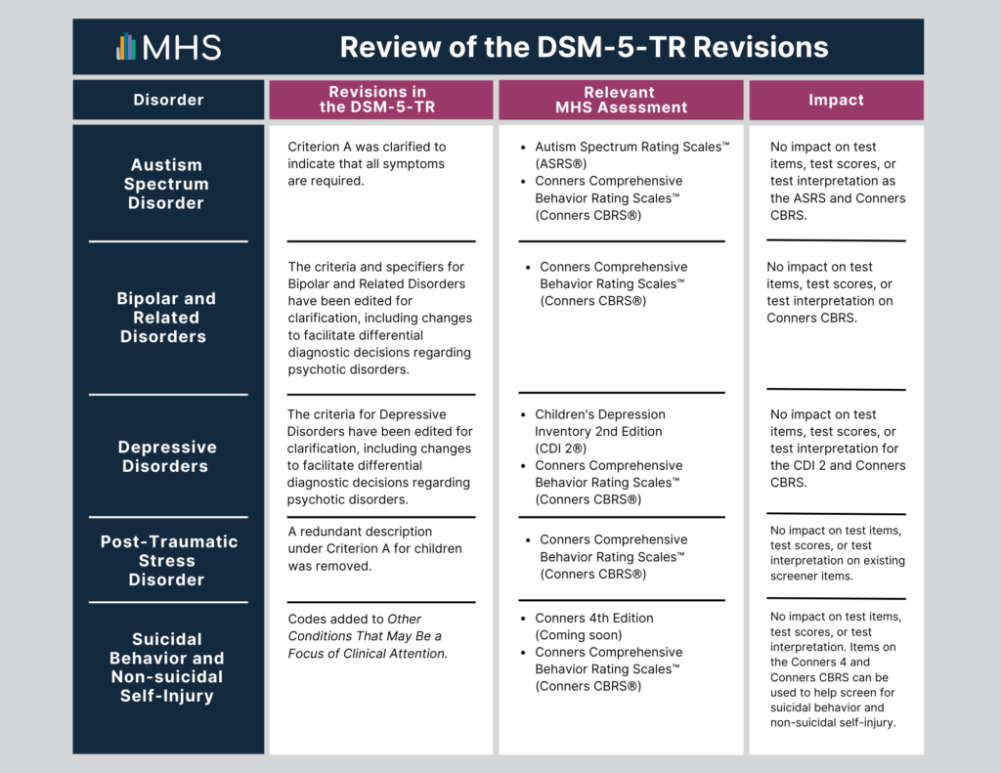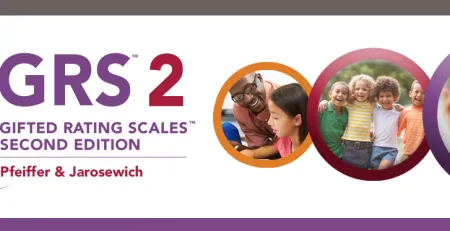A review of the DSM-5-TR revisions and impact on MHS assessments
The Diagnostic and Statistical Manual of Mental Disorders (DSM) contains descriptions of mental disorders and other psychiatric conditions across the lifespan. The manual was developed for clinical, public health, and research purposes, and the DSM is updated regularly according to new literature and scientific advances. The Diagnostic and Statistical Manual of Mental Disorders, Fifth Edition, Text Revision (DSM-5-TR) was released in March, 2022 with further updates released in September, 2022.
What changes were made in the DSM-5-TR?
The DSM-5-TR includes the addition of new disorders and psychiatric conditions, updated naming conventions, the refinement of diagnostic criteria for many disorders, and updates according to advances in current literature and fairness considerations. The following section provides a high-level summary of some of these changes. Please see the American Psychiatric Association website and the DSM-5-TR for complete changes and DSM-5-TR Update for additional changes in the September, 2022 update.
New additions of disorders include:
- Prolonged grief disorder: A disorder that applies to children, adolescents, and adults, defined as intense yearning or longing, and preoccupation with thoughts or memories of the deceased.
- Unspecified Mood Disorder: A diagnosis that was reinstated in the DSM-5-TR. It refers to symptoms characteristic of Bipolar Related Disorders and/or Depressive Disorders but do not meet the full criteria for any of the disorders under those classes.
- Major or Mild Neurocognitive Disorder Due to Unknown Etiology was added as a mental disorder under Neurocognitive Disorders.
Addition of other conditions that may be a focus of clinical attention
- Impairing Emotional Outbursts was added as Other Conditions That May Be a Focus of Clinical Attention. The condition is characterized by displays of anger or distress manifested verbally (e.g., verbal rages, uncontrolled crying) and/or behaviorally (e.g., physical aggression toward people, property, or self) that lead to significant functional impairment.
Note that Suicidal Behavior Disorder was removed as one of the conditions for further study in the September, 2022 update. Also of note, the term “commit suicide” was replaced with more sensitive and less stigmatizing language. This update is reflected in alphabetical and numerical listings, criteria, and text descriptions.
The names of the following disorders were updated according to their usage in current literature and the International Classification of Diseases (ICD-11):
- Intellectual Developmental Disorder (Intellectual Disability), formerly Intellectual Disability (Intellectual Developmental Disorder)
- Persistent Depressive Disorder, formerly Persistent Depressive Disorder (Dysthymia)
- Social Anxiety Disorder, formerly Social Anxiety Disorder (Social Phobia)
There were changes to the diagnostic criteria and specifiers for the following diagnoses:
The purpose of this addition was to clarify diagnostic criteria and differential diagnoses, remove redundancy, and increase consistency within the DSM and with the International Classification of Diseases (ICD-11):
- Attenuated Psychosis Syndrome; Other Specified Schizophrenia
- Autism Spectrum Disorder; Intellectual Disability
- Avoidant Restrictive Food Intake Disorder; Other Specified Feeding Disorder
- Bipolar and Related Disorders
- Delirium; Other Specified Delirium Disorder
- Depressive Disorders
- Gender Dysphoria
- Depressive Disorders
- Narcolepsy
- Other Specified Obsessive-Compulsive and Related Disorder
- Posttraumatic Stress Disorder
Texts were updated for most disorders according to advances in current literature and to increase adherence with principles of fairness, for example, the impact of racism on diagnoses and language use (e.g., “desired gender” was replaced with “experienced gender”). The text areas with the most changes include:
- Prevalence
- Risk and Prognostic Factors
- Culture-Related Diagnostic Features
- Sex- and Gender-Related Diagnostic Features
- Association With Suicidal Thoughts or Behavior
- Comorbidity
How were MHS assessments impacted by these changes?
Several MHS assessments, for example, the Autism Spectrum Rating Scale (ASRS®), the Children’s Depression Inventory 2nd Edition (CDI 2®), the Conners 3rd edition (Conners 3®), the Conners’ Adult ADHD Rating Scales (CAARS), the Conners Comprehensive Behavior Rating Scale (Conners CBRS®), and the Multidimensional Anxiety Scale for Children 2nd Edition (MASC 2) include items that measure symptoms of mental disorders and psychiatric conditions in the DSM.
Is the administration and interpretation of these assessments affected?
No, these assessments can be administered and interpreted as is.
The following table summarizes the impact of the DSM-5-TR on assessments published by MHS:











